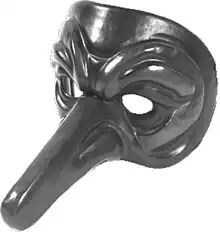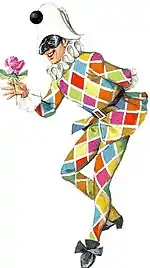Commedia dell'arte masks are a type of mask worn by performers of the Italian form of theatre, Commedia dell'arte.[1] Masks are an integral part of the performance, and each character wears a particular mask design. All masks were originally leather but are now more commonly made of neoprene. They are an extension of the actors and their costumes, hair, and accessories.[2] The masks create an entirely different face for the people wearing them.[3] Masks in Commedia dell'arte speak of the types of characters that each represents, saying that they are an unchanged type.[4][5]
Masks told the audience who the character was, their social class and type, what they would or wouldn't do, and their attitudes.[6] A comic mask is a nobody and a somebody at the same time, important even if a lowly servant. Characters who embody the upper class–usually the lovers or Innamorati–and the female servants do not wear physical headpieces, but their personalities are still referred to as "masks."[7]
Commedia stock characters introduce themselves as soon as they notice the audience, and the mask helps them to do so.[3] To the audience, the actor's physical movements and embodiment of the stock characters help establish their character, and the mask enhances this.[8] The masks and the lazzo comedic routines were connected; without the lazzo a character in a mask would be less entertaining.[3]
Commedia dell'arte originated in the 1530s and 1540s. Performers needed to be recognized immediately as the characters they portrayed.[3] Many actors see the characters as a mask; with it on, they are that specific character; without it, they are themselves or another character. Lovers can wear a mask as a disguise, however, and do not become another character. Actors are directed more by the mask than by the director; they use the movements associated with the character and follow their character's type. An actor must surrender his entire body to the character, not just change his face with the mask.[4]
Mask types

Each character's mask has specific elements and a distinct appearance that makes it recognizable in performances across the world.[3] There are four or five classes: old men such as Pantalone and Il Dottore; young and adventurous men like Il Capitano; the servant, sometimes named Zanni; and another old man but hunchbacked and more crippled: Pulcinella.[9] Servant characters such as Zanni typically have a long nose, sometimes with more curve for Pantalone, and the servants whose names end in "ino" such as Truffaldino or Arlecchino are more often small and round. In traditional masks, servant characters like Zanni should have big noses and smaller eyes. This gives them a more animal look and makes them seem more primitive, as servants are lower than the master.[3]
- The Zanni mask, one of the first, covered the full face and sometimes the head until the bottom of the mouth was removed.[4]
- Capitano's mask has a strong brow in a frown and smaller eyes as well.[3]
- Brighella is described as bearded in early mentions of masked characters.[10] He often has a mustache now, swirled up to give him a mischievous air.[4]
- Il Capitano often has a long nose like Zanni, though typically larger. He also has a mustache sometimes, but stiff and strong under the large nose, almost like spikes poking out.[11]
- Dottore sometimes has a small mustache, eyebrows, and no upper lip. His mask covers the actor's forehead and nose, exposing their cheeks so that the actor may use blush to create the look that he enjoys his spirits.[4][12]
- Pantalone is known for his red and black costume, beard, and easily recognizable mask. His long pointed beard looks almost like an extension of his equally long nose, and he sometimes has a mustache and bushy eyebrows to give him a distinct look.
Dottore and Pantalone though both older men, look very different.[13]

Each of the features may be exaggerated or missing. Dottore typically does not have cheekbones or an upper lip. One does not want to make il Dottore unrecognizable for who he is or cause confusion between the two characters because they are too similar. Much like the people you see daily, not all masks must be perfect; they can have bumps just like any person can. The characters have the same skin problems as teenagers and elders we see daily.[3]
Unmasked characters
Not all the characters in Commedia dell'arte are masked, and some have powdered faces instead. When women finally joined the men on stage, they did not initially wear masks; they wanted to show their faces as they played female lovers mostly. Men had worn masks to play women before, but one woman was playing women; they did not want to hide their faces, even if they played a servant. Their counterparts, the male lovers, also stopped wearing masks. This led to more unmasked characters, such as the "servetta (French, soubrette)," and unmasked female servants such as Colombina. Though unmasked, she wore heavy makeup around her eyes, drawing the focus there.[4]
Pedrolino did not wear a mask; instead, he had a floured face.[4] He was the first of the white-faced clowns of today.[14] These characters were still considered 'masked' because they still follow the character types. Lovers tended to wear heavy makeup containing beauty marks and heavy mascara.[4]

Mask construction
Leather is the traditional material for these masks, as it is the easiest to shape and creates a light, easy-to-wear mask that holds shape on stage.[3] There are also some made with Papier-mâché and plaster casts. Working with leather to build Commedia masks is an extensive process. Leather is first soaked for 48 hours minimum. The leather is then draped over a base molded to the shape of a face and stretched by hand or with a smooth wooden tool. The shaping is repeated, and the artist continues pushing it into the crevices formed by the mold. After the artist has manipulated the leather to its desired shape, it is dried, either with a heat source or for an extensive air-drying period. Once the leather is dehydrated, a hardening agent is applied.[15]
References
- ↑ Igawa, Momoko; Kato, Makoto (2017-09-20). "A new species of hermit crab, Diogenes heteropsammicola (Crustacea, Decapoda, Anomura, Diogenidae), replaces a mutualistic sipunculan in a walking coral symbiosis". PLOS ONE. 12 (9): e0184311. Bibcode:2017PLoSO..1284311I. doi:10.1371/journal.pone.0184311. ISSN 1932-6203. PMC 5606932. PMID 28931020.
- ↑ "Newman's Commedia Mask Company: handmade leather commedia dell'arte masks". commediamask.com. Retrieved 2016-12-08.
- 1 2 3 4 5 6 7 8 9 Fava, Antonio. The Comic Mask in the Commedia dell'Arte. Northwestern University Press.
- 1 2 3 4 5 6 7 8 John., Rudlin (1994-01-01). Commedia dell'arte : an actor's handbook. Routledge. OCLC 27976194.
- ↑ Copeau, Jacques. Reflexion d'un comedian sur le Paradoxes de Diderot'. Gallimard.
- ↑ Schmitt, Natalie Crohn. Performing Commedia dell'Arte, 1570-1630. London. ISBN 978-0-429-02304-0. OCLC 1122565400.
- ↑ Schmitt, Natalie Crohn. Performing Commedia dell'Arte, 1570-16 30. London. ISBN 978-0-429-02304-0. OCLC 1122565400.
- ↑ "Commedia Dell' Arte". www.brown.edu. Retrieved 2020-04-22.
- ↑ "The Commedia dell'arte". www.theatrehistory.com. Retrieved 2016-12-09.
- ↑ Kennard, Joseph (1967). Masks and Marionettes. Kennikat Press.
- ↑ Ducharte, Pierre. The Italian Comedy. Dover Publications.
- ↑ Tiddy, R.J. Mummer's Play.
- ↑ Rudlin, John (1994). Commedia delArte An Actors Handbook. Routledge.
- ↑ "Faction of Fools | A History of Commedia dell'Arte". www.factionoffools.org. Retrieved 2016-12-09.
- ↑ Weber, Elizabeth (2009). "Commedia dell'Arte, Masks, and Masking: A Modern Application for the Production of Commedia Masks. An Independent Research and Application Process". Kaleidescope, UKnowledge. 8: 82–87.